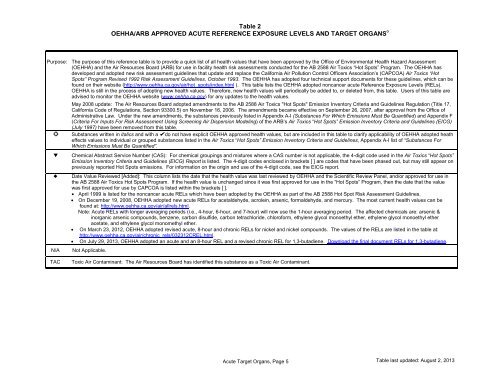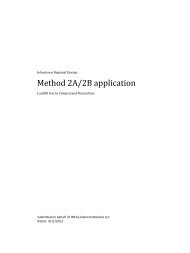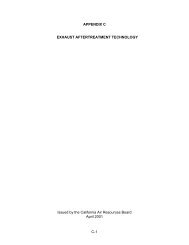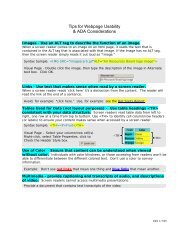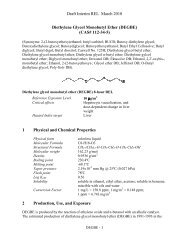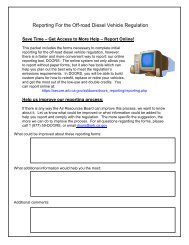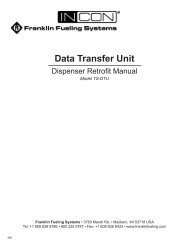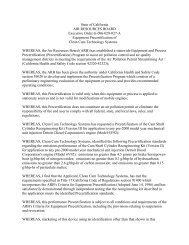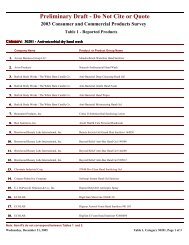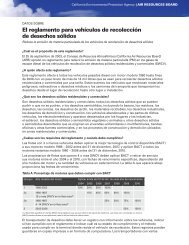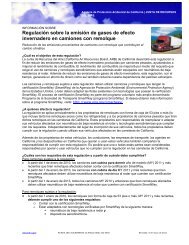August 2013 acute target organs - California Air Resources Board
August 2013 acute target organs - California Air Resources Board
August 2013 acute target organs - California Air Resources Board
Create successful ePaper yourself
Turn your PDF publications into a flip-book with our unique Google optimized e-Paper software.
Table 2<br />
OEHHA/ARB APPROVED ACUTE REFERENCE EXPOSURE LEVELS AND TARGET ORGANS ❂<br />
Purpose: The purpose of this reference table is to provide a quick list of all health values that have been approved by the Office of Environmental Health Hazard Assessment<br />
(OEHHA) and the <strong>Air</strong> <strong>Resources</strong> <strong>Board</strong> (ARB) for use in facility health risk assessments conducted for the AB 2588 <strong>Air</strong> Toxics “Hot Spots” Program. The OEHHA has<br />
developed and adopted new risk assessment guidelines that update and replace the <strong>California</strong> <strong>Air</strong> Pollution Control Officers Association’s (CAPCOA) <strong>Air</strong> Toxics “Hot<br />
Spots” Program Revised 1992 Risk Assessment Guidelines, October 1993. The OEHHA has adopted four technical support documents for these guidelines, which can be<br />
found on their website (http://www.oehha.ca.gov/air/hot_spots/index.html ). This table lists the OEHHA adopted noncancer <strong>acute</strong> Reference Exposure Levels (RELs).<br />
OEHHA is still in the process of adopting new health values. Therefore, new health values will periodically be added to, or deleted from, this table. Users of this table are<br />
advised to monitor the OEHHA website (www.oehha.ca.gov) for any updates to the health values.<br />
❂<br />
▼<br />
◆<br />
May 2008 update: The <strong>Air</strong> <strong>Resources</strong> <strong>Board</strong> adopted amendments to the AB 2588 <strong>Air</strong> Toxics "Hot Spots" Emission Inventory Criteria and Guidelines Regulation (Title 17,<br />
<strong>California</strong> Code of Regulations, Section 93300.5) on November 16, 2006. The amendments became effective on September 26, 2007, after approval from the Office of<br />
Administrative Law. Under the new amendments, the substances previously listed in Appendix A-I (Substances For Which Emissions Must Be Quantified) and Appendix F<br />
(Criteria For Inputs For Risk Assessment Using Screening <strong>Air</strong> Dispersion Modeling) of the ARB’s <strong>Air</strong> Toxics “Hot Spots” Emission Inventory Criteria and Guidelines (EICG)<br />
(July 1997) have been removed from this table.<br />
Substances written in italics and with a do not have explicit OEHHA approved health values, but are included in this table to clarify applicability of OEHHA adopted heath<br />
effects values to individual or grouped substances listed in the <strong>Air</strong> Toxics “Hot Spots” Emission Inventory Criteria and Guidelines, Appendix A-I list of “Substances For<br />
Which Emissions Must Be Quantified”.<br />
Chemical Abstract Service Number (CAS): For chemical groupings and mixtures where a CAS number is not applicable, the 4-digit code used in the <strong>Air</strong> Toxics “Hot Spots”<br />
Emission Inventory Criteria and Guidelines (EICG) Report is listed. The 4-digit codes enclosed in brackets [ ] are codes that have been phased out, but may still appear on<br />
previously reported Hot Spots emissions. For information on the origin and use of the 4-digit code, see the EICG report.<br />
Date Value Reviewed [Added]: This column lists the date that the health value was last reviewed by OEHHA and the Scientific Review Panel, and/or approved for use in<br />
the AB 2588 <strong>Air</strong> Toxics Hot Spots Program. If the health value is unchanged since it was first approved for use in the “Hot Spots” Program, then the date that the value<br />
was first approved for use by CAPCOA is listed within the brackets [ ].<br />
• April 1999 is listed for the noncancer <strong>acute</strong> RELs which have been adopted by the OEHHA as part of the AB 2588 Hot Spot Risk Assessment Guidelines.<br />
• On December 19, 2008, OEHHA adopted new <strong>acute</strong> RELs for acetaldehyde, acrolein, arsenic, formaldehyde, and mercury. The most current health values can be<br />
found at: http://www.oehha.ca.gov/air/allrels.html.<br />
Note: Acute RELs with longer averaging periods (i.e., 4-hour, 6-hour, and 7-hour) will now use the 1-hour averaging period. The affected chemicals are: arsenic &<br />
inorganic arsenic compounds, benzene, carbon disulfide, carbon tetrachloride, chloroform, ethylene glycol monoethyl ether, ethylene glycol monoethyl ether<br />
acetate, and ethylene glycol monomethyl ether.<br />
• On March 23, 2012, OEHHA adopted revised <strong>acute</strong>, 8-hour and chronic RELs for nickel and nickel compounds. The values of the RELs are listed in the table at:<br />
http://www.oehha.ca.gov/air/chronic_rels/032312CREL.html.<br />
• On July 29, <strong>2013</strong>, OEHHA adopted an <strong>acute</strong> and an 8-hour REL and a revised chronic REL for 1,3-butadiene. Download the final document RELs for 1,3-butadiene.<br />
N/A Not Applicable.<br />
TAC<br />
Toxic <strong>Air</strong> Contaminant: The <strong>Air</strong> <strong>Resources</strong> <strong>Board</strong> has identified this substance as a Toxic <strong>Air</strong> Contaminant.<br />
Acute Target Organs, Page 5<br />
Table last updated: <strong>August</strong> 2, <strong>2013</strong>


